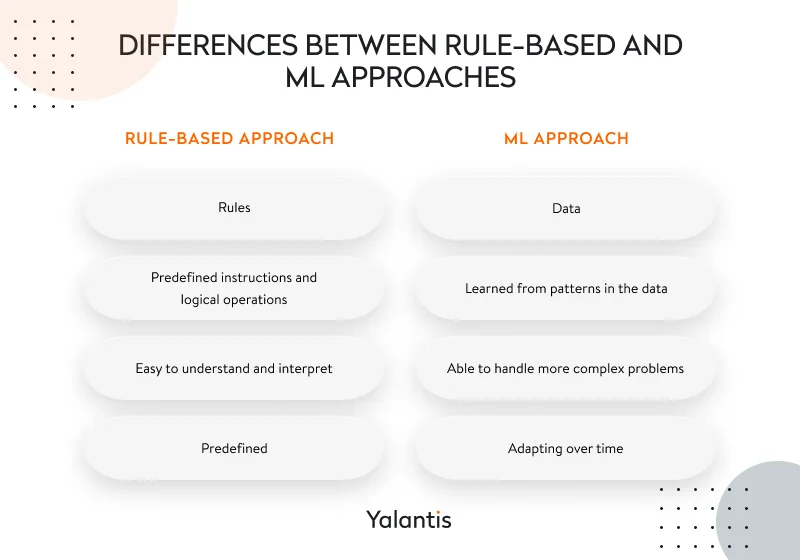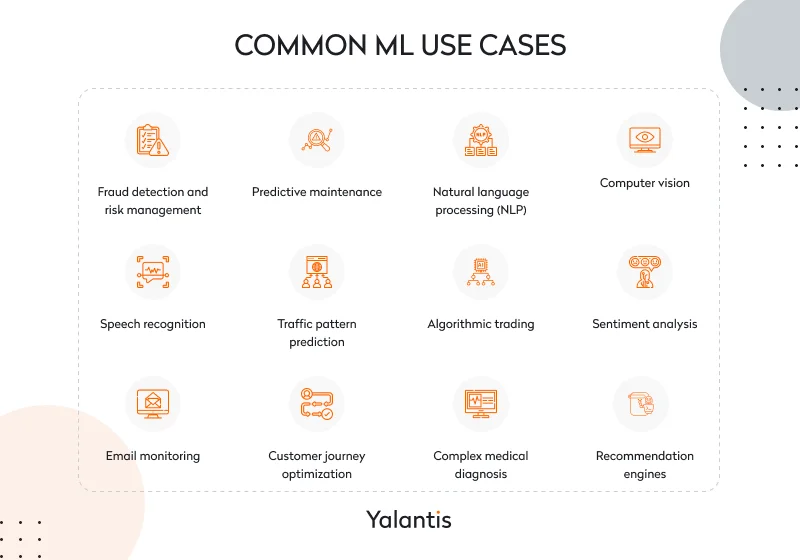
How to streamline your ML software development project
Machine learning (ML) can enable a business to harness the power of data to drive innovation. A successful ML solution can achieve revenue growth, offer a competitive advantage, improve automation, bring efficiency gains, and provide actionable insights.
Statista predicts the ML market will experience a compound annual growth rate (CAGR) of 18.73 percent between 2023 and 2030, leading to a market volume of $528.10 billion by the end of that period. This strong growth creates the feeling that literally every business needs to implement ML — especially when there are so many widely discussed use cases. So, is ML the magic pill for your business needs? To determine if ML can help you achieve your business goal or solve a business problem (and how), you need to understand:
- how this technology works
- its place in the hierarchy of artificial intelligence (AI) technologies
- its main capabilities and limitations based on examples of machine learning use cases
This knowledge is critical, as there’s a lot of confusion about AI and ML that leads to:
Overgeneralization. AI and ML are often used as broad terms encompassing various technologies, leading to misunderstandings of their specific capabilities and limitations.
Unrealistic expectations. Due to media portrayals and hype, it’s a common misconception that AI and ML can solve any problem, leading to disappointment when the technology’s actual capabilities are understood.
Skepticism. AI and ML are complex topics. A lack of understanding can lead to skepticism about them and unjustified refusal to implement them even when they are likely to be highly beneficial.
That said, you don’t need broad knowledge of ML to check if it can be beneficial for your company or a specific business case. To figure that out, just read this article, which describes common machine learning use cases and offers an overall roadmap for setting up and implementing a successful ML-driven project.
Discover how to drive business value with AI and avoid expensive missteps
Explore our white paperThe role of ML in the AI landscape
Let’s figure out what AI, ML, and deep learning (DL) are at a basic level, which is sufficient for our purposes.
Artificial intelligence refers to systems capable of performing tasks that typically require human intelligence. The growing demand for AI development services has accelerated the adoption of such systems across various industries, revolutionizing how tasks are performed. ChatGPT, a language model that has recently become the stuff of legend, is a great example of an AI use case. ChatGPT can process and understand text, engage in dialogue, and provide intelligent human-like responses.
Machine learning is a subset of AI focused on designing algorithms and models that automatically learn patterns, make predictions, or take actions based on data. In an ML-driven project, a set of algorithms and models are fed with structured data to carry out a task without being programmed how to do so. Leveraging big data services, these algorithms can process vast amounts of data to provide more accurate predictions and insights. When it’s effective, a trained ML algorithm uses data to answer a question, and this answer can be accurate and impossible even for human experts to provide.
Deep learning is a specialized subset of ML that concentrates on training artificial neural networks with multiple layers (deep neural networks). ChatGPT uses advanced DL techniques to understand and generate human-like (generative ai development) text based on complex patterns and relationships it has learned from training on vast amounts of textual data.

Is ML suitable for your business case?
Here is a list of the main preconditions for a successful ML-driven project to answer the question above:
1. Set specific goals and identify the key problem
Having clear project goals and a well-defined problem statement provides focus and direction, enabling effective planning, data collection, algorithm selection, and evaluation of results. It helps align stakeholders’ expectations, ensures efficient resource allocation, and facilitates communication and collaboration throughout the project.
For example, the goal of an ML-driven project might be the development of a predictive model that accurately detects fraudulent transactions in real time for an e-commerce platform, reducing financial losses and improving customer trust. In this case, the problem statement might be leveraging historical transaction data to train an ML model capable of identifying fraudulent transactions with a high level of accuracy, minimizing false positives and false negatives.
2. Make sure you have enough quality data
Having a significant amount of quality data is critical for achieving accurate and reliable results in AI-driven projects. This need is especially acute for ML-driven projects where sufficient high-quality data allows the model to capture a wide range of patterns, relationships, and variations present in the data. A large amount of quality data provides the foundation for building accurate and reliable ML models. Data analytics services can also play a crucial role in helping businesses understand the data landscape, identify gaps, and enhance the overall data quality. On the contrary, insufficient or low-quality data can result in incomplete or biased learning, leading to suboptimal performance.
You can understand if you have enough reliable data for your ML-driven project by evaluating the volume, quality, relevance, distribution, and accessibility of available data in relation to the project’s requirements and the performance expectations of ML algorithms.
3. Rule-based or ML: What’s your cup of tea?
There are cases when the rule-based approach is preferred over the ML approach for problem-solving and decision-making. Rule-based systems operate according to a set of predefined rules programmed by humans. These rules define the logic and decision-making process and are typically in the form of if–then statements, where specific conditions (if) lead to predetermined actions or outcomes (then). Rule-based systems are well-suited for problems with clearly defined and predictable patterns, where human expertise and domain knowledge can be explicitly encoded into rules. For example, quality control, medical diagnosis, and workflow management systems might be rule-based.
See that your problem can be solved with a rule-based approach? Then go for it. It will allow you to build a transparent and explainable system. ML models are typically more complex. Moreover, taking the ML approach in such a case would be counterproductive, since it requires extensive data, training, and computational resources to learn patterns and make predictions. But you should choose the ML approach if you need to deal with complex patterns, large datasets, unstructured or ambiguous data, and adaptive systems.

To help you conclusively determine if the ML approach is effective for your business case, let’s look at the most common machine learning business use cases based on business type and size. Most likely, one of them will intersect with your project idea.
Common ML use cases for a successful ML-driven project
Machine learning is well-suited for the use cases below because such projects benefit from identifying complex data patterns, the use of large datasets, and the ability to learn from examples.
Fraud detection and risk management. This is one of the most common uses for machine learning. In finance, insurance, and e-commerce, ML can help identify fraudulent activities, detect anomalies, and assess risks.
Predictive maintenance. ML can be used for predictive maintenance in the manufacturing, transportation, and energy sectors. By analyzing sensor data and historical maintenance records, businesses can predict equipment failures, schedule proactive maintenance, and minimize costly downtime.
Natural language processing (NLP) helps to analyze and get insights from textual data. NLP tasks include text classification, named entity recognition, and language translation.
Computer vision. This expertise allows businesses to use ML for visual recognition, image analysis, and object detection tasks. Computer vision is applicable in healthcare, retail, manufacturing, and security, enabling businesses to automate processes, enhance quality control, and improve the user experience.
Speech recognition. ML models can be trained to turn spoken language into written text. This can improve voice assistants, transcription services, and voice-controlled systems. Speech recognition is applicable in customer service, healthcare, automotive, transportation, and other industries.
Traffic pattern prediction involves utilizing ML algorithms to predict traffic conditions and patterns in transportation networks. By analyzing historical traffic data, real-time sensor data, weather conditions, and other relevant factors, ML models can predict traffic flow, congestion, travel time, and potential bottlenecks.
Algorithmic trading. ML algorithms can help analyze vast volumes of financial data and make automated trading decisions by identifying patterns, trends, and correlations in market data to generate trading signals, execute trades, and manage portfolios.
Sentiment analysis. As a subset of NLP, sentiment analysis specializes in interpreting the sentiment or emotion behind text data, such as social media posts and customer reviews. ML models are trained to analyze language, context, and linguistic cues to define if sentiment is positive, negative, or neutral. Sentiment analysis has applications in market research, brand monitoring, customer feedback analysis, and reputation management.
Email monitoring involves leveraging ML techniques to analyze and process email communications for various purposes, such as filtering spam, detecting malicious content, categorizing messages, and extracting valuable information.
Customer journey optimization. The use of ML algorithms can help to analyze and optimize the end-to-end customer journey across various touchpoints and interactions with a business or brand to improve the customer experience, customer satisfaction, and business outcomes.
Complex medical diagnosis. ML algorithms and techniques can be used to assist in diagnosing patients with conditions such as skin cancer. ML models can be trained on large datasets containing medical records, patient information, symptoms, and diagnostic outcomes to learn patterns and identify correlations.
Recommendation engines. ML algorithms can help online businesses offer users personalized recommendations. Recommendation engines analyze user preferences, behaviors, and historical data to suggest relevant items or content that users are likely to be interested in. Recommendation engines are widely used by e-commerce platforms, streaming platforms, news aggregators, and social media platforms.

If the preconditions and use cases for machine learning above have convinced you that the ML approach is the way to go, it’s time to learn the specifics of implementing ML depending on the size of your business.
Peculiarities of ML implementation for businesses of various sizes
Implementing machine learning can look different for businesses of different sizes due to variations in available resources, budgets, data volume and quality, technical expertise, and organizational complexity. To successfully implement such projects, it is crucial to collaborate with a reliable data science development company that has expertise in delivering tailored solutions for specific business needs. The bigger a business is, the more challenging it becomes for it to ensure smooth data integration due to the increasing number of internal systems and data as well as the need for its synchronization.
Small businesses typically have limited resources and need to prioritize specific machine learning cases that align with their budget, data availability, and capabilities. They tend to build targeted solutions (demand forecasting, fraud detection, customer segmentation, sentiment analysis, and others) to gain a competitive advantage.
Midsized businesses try to grow their technical capacity for improved scalability and innovation. To achieve this goal, they can implement predictive analytics, NLP, image or video recognition, process optimization, and anomaly detection solutions.
Large businesses or enterprises may have dedicated AI departments along with sufficient resources and enough relevant data to benefit from the enterprise-wide impact of ML-related initiatives. Such a large-scale impact might boost decision-making across departments and functions and improve operational efficiency and risk management. Moreover, enterprise-wide ML implementations can even drive the development of new products, services, and business models.
No matter how large your business is and what ML use case you want to implement, you need an effective plan for implementing it. Further, we talk about how to plan and execute a successful ML project.
ML project lifecycle: steps on the road to effective implementation
The ML project lifecycle refers to the sequence of stages and activities involved in the development and deployment of an ML project (lifecycle data management).
- Define the problem and set project goals. Analyze your business and determine where ML can be effectively used. The main purpose here is to define the objective and scope of the ML project. Consider your limitations, including your budget, timeline, available expertise, and available data. Make a detailed overview of the case you want to solve with ML. Articulate the problem statement and establish goals, metrics, and success criteria.
- Collect data. Data collection involves gathering the relevant data required for the project. This can include acquiring existing datasets, collecting new data, or a combination of both. Data should be representative, diverse, and of sufficient quality to ensure accurate model training and evaluation.
- Analyze and clean the data. Analyze the collected data to gain insights and identify any issues or inconsistencies. Data cleaning involves handling missing values, removing outliers, addressing data inconsistencies, and transforming the data into a suitable format for analysis.
- Perform a feasibility study. Conduct a feasibility study to assess the viability of applying ML techniques to solve the defined problem. This involves evaluating factors such as data availability, computational resources, expertise, time constraints, and potential ethical or legal considerations.
- Develop and train the model. Design and develop an ML model based on the problem statement and data. Split the data into training and validation sets, and train ML algorithms on the training data to learn patterns and relationships. Iteratively refine the model to improve its performance and ability to generalize.
- Fine-tune the model. Fine-tuning involves optimizing the model’s hyperparameters — such as learning rate, regularization, and network architecture — to achieve better performance. This step aims to strike a balance between underfitting and overfitting, ensuring the model can effectively generalize unseen data.
- Integrate the model. Once the model is trained and fine-tuned, integrate it into the desired application or system. This involves setting up the necessary infrastructure, APIs, or interfaces to incorporate the model’s predictions or insights into the target environment.
- Refine the model. Continuously monitor and evaluate the model’s performance in a real-world setting. Feedback from users, performance metrics, and ongoing data collection can help you identify areas for improvement. Refine the model by incorporating new data, retraining the model, or updating algorithms to enhance its accuracy and relevance.
- Monitor and maintain the model. After deployment, regularly monitor the model’s performance. This involves tracking key performance metrics, detecting any drift or degradation, and conducting periodic maintenance and updates to ensure the model’s effectiveness, reliability, and alignment with changing requirements.
During the first step of the ML project lifecycle, you’ll need to choose an optimal technology stack. That’s when the project strategy decision tree will serve you well.
How a project strategy decision tree helps to create a workable ML solution
A project strategy decision tree is a visual representation or diagram that guides the decision-making process when developing a project strategy. It presents a hierarchical structure of decisions and their potential outcomes, allowing project managers and teams to systematically evaluate and choose the most appropriate strategies based on specific criteria.
Using a project strategy decision tree, you can systematically evaluate different technology stacks, consider relevant criteria, and make informed decisions that align with the specific needs and goals of your ML-driven project.
There are two common approaches to the technical implementation of an ML-powered project:
- If you don’t have in-house ML expertise and you need to handle a common ML use case, use a suitable SaaS solution (such as IBM Watson Studio, Databricks, or DataRobot).
- If you need to quickly set up the required infrastructure, access pre-built tools and frameworks (such as TensorFlow, Keras, PyTorch, and Caffe), obtain computing power and resources, and validate the feasibility of your AI and ML initiatives, use AI and ML infrastructure or managed services (such as AI managed services by Amazon, Microsoft, or Google).

Having viewed the overall approach to implementing an ML-driven project, let’s see how to build an appropriate architecture for an ML solutions based on a fictional example.
Designing an optimal architecture for an ML project
Imagine you have a blog with over 500 articles and around 1,000 unique visits per day. The problem is that only 0.5 percent of visitors fill out the contact form. During initial communication with potential clients, most ask for articles showcasing your expertise even though they are already available on the website. While searching for services, potential clients often miss such articles and may think that a company doesn’t have the required experience. To solve this problem, you can benefit from ChatGPT’s capabilities. Follow the steps described below.
1. Create an architectural vision
To develop the solution architecture, you need to create an architectural vision, which is the high-level view and strategic direction of the architecture, outlining its desired future state, goals, and principles. An architectural vision can be created based on the most important architecture drivers: business goals, use cases, and constraints. For this project, they will be as follows:
Business goals:
- Decrease the time for lead conversion by 50 percent.
- Increase the sales team’s efficiency by providing a convenient article knowledge base.
Use cases:
- Prospects can use a chatbot on the website to find relevant articles.
- The sales team can use a chatbot in Slack to find relevant articles by keywords.
Constraints:
- Implementing the project should be cost-effective.
- The system should be developed by one engineer within two months.
2. Consider architectural concerns
You should take into account all factors that might affect the future solution’s quality and feasibility. Here are the architectural concerns for the project we’ve described:
- To ensure that the chat provides accurate information, ChatGPT by OpenAI should be trained with your derived data. Without it, ChatGPT will provide answers that are too generic and may be irrelevant to your company.
- Training data should be verified and fine-tuned by the sales team to ensure that the chatbot broadcasts your corporate tone of voice.
- ChatGPT is known to be bad at finding links to existing pages (consequently, there is a need to validate and regenerate links after ChatGPT).
Suppose you decided to create a proof of concept (PoC) to verify the feasibility of adding training data to ChatGPT and check the accuracy of links it provides to your corporate website. The developed PoC helped you make sure that links generated by ChatGPT lead to 404 pages in most cases, requiring you to validate and regenerate them.
3. Develop the business architecture
A business architecture diagram shows all the systems we have within the project (we will create some of them from scratch and the rest will be ready-made solutions). The diagram should also include all actors working with these systems. The following is an example of what the business architecture for the described project might look like:

4. Resolve the dilemma of adopt or build
Next, you need to decide which existing solutions (paid or open-source) to adopt and which to build yourself. We advise creating custom solutions only if they have the potential of bringing you a competitive advantage or enabling you to get more profit or clients. Otherwise, use ready-made solutions since the less code, the shorter the time to market and the fewer development bottlenecks you’ll face in the future.
For the project described, we would advise you to create the following solutions:
- Website chat UI to ensure strong company branding and provide a better user experience than competitors
- A training data set to ensure the chatbot transmits your corporate tone of voice while communicating with prospects
- An API to connect all adopted solutions, since you are unlikely to find a proper ready-made solution for this purpose
5. Choose the most appropriate solutions
Use a decision log, technology radar, and reliable metrics to make the final decision on the best technology solution, be it a framework or a programming language.
- A decision log is a record of the decisions made during the process of evaluating and choosing the most suitable technology solution for a specific purpose. It includes information about the technologies considered, evaluation criteria, decision rationale, stakeholders involved, and any supporting documentation or references.
- Technology radar is a tool used to track and assess emerging technologies, trends, and practices in the software development industry.
- Other parameters to consider include the number of stars on GitHub, containers in Docker Hub, questions on Stack Overflow, and freelancers on Upwork.
6. Identify all risks (tradeoffs) in your architectural solution
Perform tradeoff analysis to evaluate and make optimal decisions about various architectural options by considering the tradeoffs associated with each choice. This involves assessing the advantages, disadvantages, and impacts of different architectural decisions to identify the optimal solution for a specific software system.
The table below is the result of conducting tradeoff analysis for the project described in this post. Each row of the table is an architectural decision (AD). Each column is an architectural driver (a key requirement or consideration that influences the design and development of an architectural solution) outlined at the architectural vision stage: business goals (BG), use cases (UC), concerns (CN), and constraints (CT).
Marks at the intersection of rows and columns characterize the architectural decisions as follows:
- S (sensitive) — AD is critical to ensure, as the driver won’t be met if it isn’t
- N (non-risk) — AD is optional to ensure, as the driver will be met even if it isn’t
- R-1 (risky) — The sales team has to verify the spreadsheet data, which might be time-consuming
- T-1 (tradeoffs) — Refining links using Google Search API is obligatory but will prevent meeting the project deadline

As you can see, implementing a successful ML-driven project is a complex process that might require years of expertise and accumulated knowledge. If you decide to cooperate with an AI and ML development provider, pay attention to their expertise in ML algorithms and techniques, portfolio of AI-powered projects, and professional recognition. Yalantis has been proclaimed a leading AI development company by C2Creview, a research and IT company review platform. We consult and create quality software utilizing AI, data science, and business intelligence and advanced business analytics solutions.
Rate this article
3.8/5.0
based on 30 reviews







